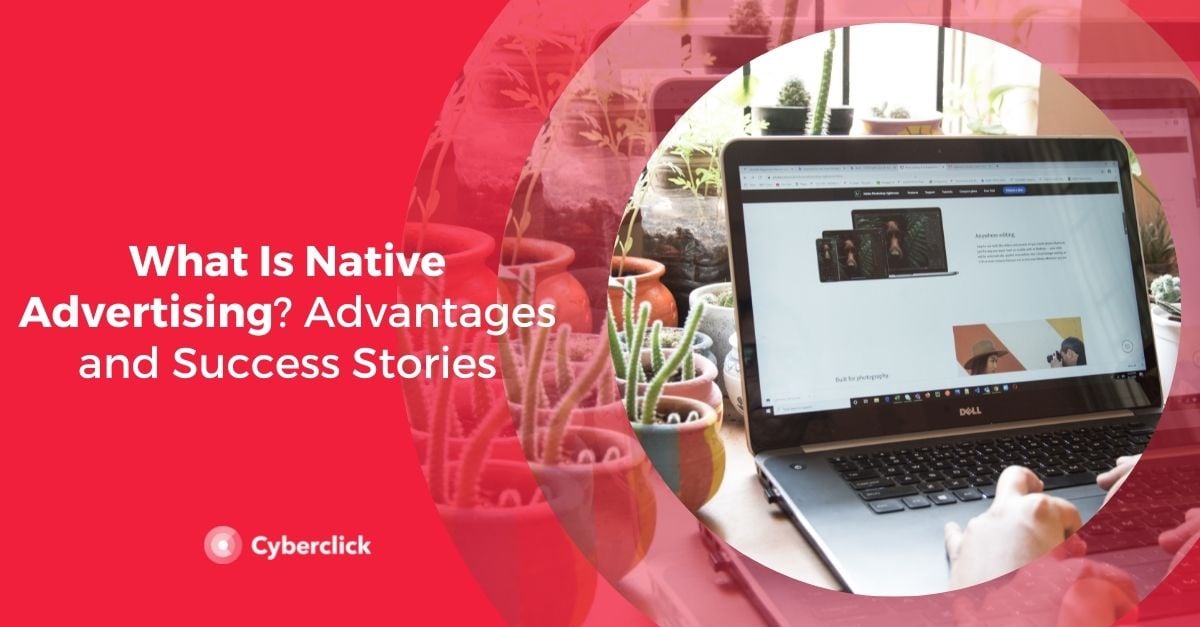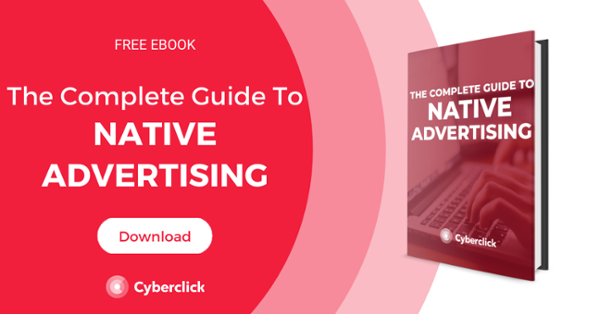By David Tomas, on 5 December 2018
What is native advertising? Envision two different situations. In the first one, you are calmly looking at your favorite website. Suddenly, you come across advertising banners to the left, right, above, and even below the content. In the second scenario, you are reading an article on a different website. Once you are finished, the website recommends that you read another post that was created by another brand.
Which one inspires more trust in you? If you chose the latter, you have fallen into the sweet embrace of native advertising.
Native advertising is based on putting yourself in the consumer’s shoes and looking for a way to offer them relevant information in a non-intrusive way. This format improves the user’s navigation experience in exchange for the user's trust and interest.

Characteristics of Native Advertising
If you have not yet joined this revolution, you may want to know a little more about what characterizes this particular type of online advertising.
- Content advertising integrates online advertising into web pages by using the content as support. It respects the format and editorial style, but, and this is important, it must be explicitly specified that it is advertising content.
- Native advertising will be successful if the content is of good quality and useful. Think about how to sell your brand with an interesting and entertaining story. If you are able to create content like this, you will increase the probability of your readers remembering your brand and your product or service.
- In order to increase engagement, offer content (articles, videos, etc) where you identify your client's needs and show why your product/service is the perfect solution. If you start by listing all the benefits of your product, people will lose interest. Instead, capture their attention with valuable information that is so interesting and attractive that they will want to share it with their network.
- Finally, keep in mind the importance of optimizing and adapting native advertising to different devices and platforms. You can make the most of videos, images, and other dynamic formats so that the user can respond to your content and engage with your brand.
Take a look at this native advertising example in which we developed a campaign for Switzerland Tourism. For other success stories, check out these examples of native advertising.
Advantages of Native Advertising
In contrast to other more traditional and invasive advertising formats like banners or pop-ups, native advertising has the ability to attract the user's attention.This makes it less intrusive for the user. Furthermore, it contains information that is useful and valuable for users, making it more likely to be shared on social media, which in turn will reach more users.
Because of how they appear on social media, many traditional advertising formats have suffered a decline in usage. On the other hand, branded content continues to rise because of its excellent potential for results and impact on users. Native advertising has a 41% higher chance of a user actually acquiring the brand's product or service.
Native Advertising Is Favored by Consumers and Brands
According to a study by OPA (Online Publishers Association), 53% of respondents surveyed expressed that they felt more attracted to native advertising than traditional forms of advertising. 52% of people said that they would be willing to buy the products or services promoted in these types of digital content. Lastly, in terms of engagement, 32% of people stated that they felt engaged enough to share the content on social media.
Once again, it is evident that native advertising wins the battle in online environments. It attracts more attention and has a greater likelihood of going viral on social media.
Types of Native Advertising
According to IAB Spain’s classification, there are two types of native advertising in digital environments:
Open: Consists of promoting the same content on various platforms or pages that share the same topic. This type of advertising, shared on various platforms at once, is possible thanks to tools such as Taboola or Outbrain.
Closed: Closed native advertising is published by a specific page or environment and is formatted according to that environment's style. Take, for example, a post on a specific blog, or an advertising message on a social network, like Twitter or Facebook.
According to the classification established by IAB USA in their guide “Native Advertising Playbook,” native advertising can be divided into 6 different types:
- 1. Advertisements integrated into the Editorial Content: All content that includes a sponsored message and is perfectly integrated into the environment in terms of format and style. These messages blend in perfectly and look like they belong on the website. Aesthetically, they comply with the format and style of what’s around them, allowing them to go unnoticed. These ads allow users to interact with them without having to leave a page or interrupt their navigation.
2. Advertisements on Search Engines: The most popular search engines, like Google, allow companies to highlight their links in the results obtained by the users' search. These sponsored links, which come with a disclaimer that identifies the brand or page, appear at the top of the page of results, just above the naturally obtained links.
3. Recommendation Widgets: Unlike the others, these advertisements do not adopt the format of the rest of the content of the page. Instead they contain messages such as “don’t miss this” or “we recommend." Some of the recommendation widgets most used by advertisers are Taboola or Outbrain.
4. Promoted Lists: These advertised messages blend in perfectly with the rest of the content on a page. In other words, they are presented identically to the other products found on the page. Amazon is the best example of a page that uses promoted lists.
5. Standard Advertisements integrated with native advertising: These are found outside of the editorial area of the page and don't share the format of the rest of the content. Instead, they appear as display ads, even though they are set apart from the rest of the page by an identifying label. Furthermore, these ads are linked and redirect to an external page or to the advertiser.
6. Tailored native advertising: Undoubtedly, this is the most creative form of branded content. In contrast to the formats listed above, this one is created by the advertiser's editorial teams. This type of content can take on many creative formats and allows for total creative freedom.
Native Advertising on Social Networks
How do you include native advertising on social media? The most common way is to include native messages in editorial environments, either as sponsored articles or blog posts. Below are some examples of native advertising on social networks.
Facebook: This type of advertising can be found on Facebook’s NewsFeed.
Google: The most popular search engine introduced native advertising through TrueView on Youtube. With this, many of its advertisers were able to achieve a CTR of 4%–a huge success!
Twitter: Twitter was one of the first social networks to include native ads in messages. There are two types of ads: Promoted Trends (promoted news that appears just above the Trending Topics of the country) and Tweet Cards, which contain images and descriptions.
LinkedIn: You can engage prospects with native ads that appear in the form of direct messages. They include personalization, copy, a call-to-action, and the option to link to your brand or website.
Pinterest: Some of Pinterest’s famous pins are sponsored by advertisers. Pinterest includes native messages on the network that are accessible to all of its users.
In summary, Native Advertising offers high-quality, useful, updated information to the user through platforms like social media, blogs, and other digital communications. Therefore, it can benefit all parties.
How to Start a Native Advertising Campaign
We have spent some time talking about native advertising, explaining what it is and its benefits. Here you can learn in detail about how to start a Native Advertising campaign. It starts with e defining your target audience and ends with managing your expectations well.
- Define your Target Audience
Defining and deeply knowing your target audience is essential for content advertising to be effective. This way, you can operate off their interests and create valuable content to help differentiate yourself from the competition.
- Pay Special Attention when Creating Content
Once you have a clear definition of your audience, you can create content perfectly suited to it. Remember that your main goal is not to promote the benefits of your products or services, but to separate yourself from the competition by offering value. As a rule of thumb, the content should always be related to the environment while also being useful for the user.
- Analyze Periodically
The analysis is the foundation of any successful strategy. The main metrics you should keep tabs on are: the number of visits for each piece of content, click-through rates, and bounce rates. With this data, you can obtain valuable information about what content generates interest or isn't providing any value. It is important to also pay attention to traffic sources–where most readers come from, the seasonality of visits, and if traffic filters in on any particular day or month of the year.
- Optimize as Necessary
The purpose of conducting a comprehensive analysis is to find errors or areas for improvement in the campaign. Once you detect the weak spots, try to find the reasons–react as soon as possible and monitor how the improvements are performing. This is imperative for continuous improvement.
Have you noticed that a piece of content has a bounce rate that is too high? Perhaps you could improve it– either visually or even by making it more appealing for the reader.
- Properly Manage Expectations
Orientating a native advertising campaign to a sales target is one of the worst mistakes that can be made. You should note that it is a slow process when it comes to conversions and that the goal in these cases is to be useful to the users and inject value, so much so that when the need arises, they will think of us as the first choice.
Instead of measuring the results on a sales or lead generation basis, pay attention to the benefits in terms of recommended content and the growth of direct searches your brand will experience in the medium/long term.
5 Tips for Creating Attractive Titles in a Native Advertising Campaign
Compared to traditional formats of online marketing, native advertising (and more specifically, content advertising) is positioned as a method with more growth for qualified site traffic. Remember, brands should always offer added value through content.
While it is necessary to develop a comprehensive Content Advertising Strategy, the title is crucial to the success of the campaign. Why is this so important? In these types of campaigns, the title is usually the first online interaction between users and the brand. The title is, therefore, the first (and perhaps the only) chance to attract the attention of your target audience.
Here are five tips for creating attractive headlines that can attract quality traffic to your site:
Titles should be short, simple and direct. They need to arouse the reader's attention, so it needs to be concise and clear enough to make the reader continue reading. Using complicated or verbose language can distract the reader from your content.
Don't mislead your users. A misleading title may help you get a good CTR, but if the reader doesn’t find what they were expecting, it will hurt their relationship with your brand.
Numerical Lists work! A list has the advantage of concisely describing what the reader will find and the length of the content. For example, the headline "The 10 places you can not miss if you go to Paris with children" got a 75% higher CTR over the headline "What to visit in Paris if you go with children."
Try to use specific words. Don’t always use the same puns and words like "things".
Create urgency and necessity. Including urgency and/or necessity (i.e. expressions like "only 15 minutes," "must," and "you have to see”) helps intrigue the user and enhance the click-through rate. Terms like "everything you need to know" or "incredible" show a CTR 24%-44% lower than when they aren't used.
While these tips may be helpful to create a catchy title and attract users, do not forget that each sector is different and each target can respond to different stimuli. Therefore, it is essential to periodically analyze the most relevant metrics (CTR, time of visit, bounce rate, etc.) and continuously optimize to find the perfect title.
Native Advertising in a World of Ad Blockers
Many consumers are tired of intrusive advertising and for this reason, applications that block this type of content are installed. Cue, Ad Blockers. They block malware domains, banners, popups and video ads- including on Facebook and YouTube.
There are almost 764 million people who use Ad Blockers. Many people install these solutions due to the highly intrusive ads, such as windows 'popovers' and 'interstitials' sections that obscure the page trying to be viewed. This lead to more and more direct conversion costs.
Therefore, publishers and marketers should increasingly propose campaigns with content advertising to improve engagement and bring higher returns for the brand. With these advertisements, you can get into the skin of consumers and connect with them through valuable content they can interact with and learn from.
David Tomas @davidtomas gave a very interesting presentation on Native Advertising during inbound Marketing Made in Madrid 2015. Check it out below!


